David Alan Harvey Workshop, entry 4: My essay topic turns from the loft building to Mormon missionaries in New York City
 Friday, January 6, 2012 at 12:43AM
Friday, January 6, 2012 at 12:43AM 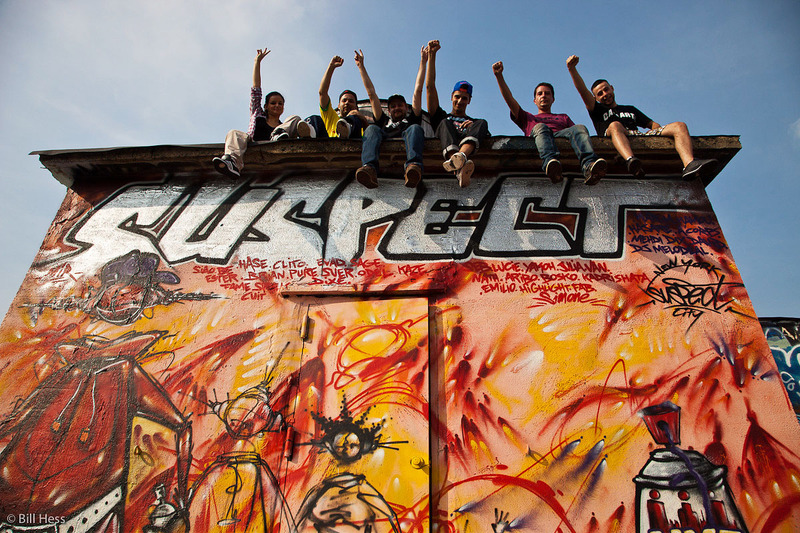 Remi, second from right, and his crew, with his completed painting.
Remi, second from right, and his crew, with his completed painting.
I photographed my father's death, along with the events that closely preceded it and those that followed soon after. During Dad's final hours of wakefulness, my sister sat down on the side of his bed with her laptop computer open to show him a black and white photo taken from his B-24 during the air war against Germany. I grew up with this photo. My earliest memories reach back to it. In it, there is flak in the air. The B-24 that had been flying in formation next to Dad's has been hit. It has rolled onto its side. Flame and smoke tear out from the fuselage, from which one wing has broken off and is peeling backwards. Debris pocks the air.
Had that tragedy ocurred just one plane over, then I likely would never have been.
On the final day of his life, I left Dad's deathbed to drive to one of his favorite sandwich shops. I bought several sandwiches - none for him, but for those family members keeping vigil. On the way back to the medical center, I saw two Mormon missionaries - one Polynesian, the other white - standing on a dusty sidewalk at the edge of a new subdivision, talking to a youth clad in baggy, red and black shorts that hung just past his knees.
I raised my camera and snapped off three frames as I drove past. This is what I always do when I come upon Mormon missionaries. I take their pictures. Then, sooner or later, I pull up the pictures, look at them, and wait to see what story from my own days as a Mormon missionary first come to mind. I then write that story, and put it and the picture together.
It is a very long-term project, advancing at turtle speed. I call it, Looking Back at Me.
We knew Dad would hold on through Veterans Day and he did, then passed away at the very beginning of May 29, 2007. My oldest brother wanted me to stay with him in the house that he had inherited from my parents well before their deaths, but, with my parents no longer living, I could not stay in that house. I returned to my motel, got what sleep I could and then in the afternoon of a hot day, took a walk through a park near my parents' home. I soon came upon two Mormon missionaries.
A light, pink, tie hung down over from the neck of Elder Jones to drape his white shirt. He was from Kodiak, Alaska, and was serving the final days of his two-year mission in Utah's Salt Lake Valley. I took a portrait of him as his companion appeared in the background, mingling with young people who had been playing soccer.
The second day of the David Alan Harvey Loft Workshop was the first day of any real work. It began with us students showing the slide shows that David had asked us to bring as a way to both introduce ourselves to the group, and to give him the opportunity to give us all a striking critique in picture editing.
He had asked that we include about 20 images in our slide shows. I immediately figured out what I wanted to show. I would sum up my entire career - beginning with the influences that led me to become a photographer - in 20 frames. I would begin with the photo of my dad lying in his deathbed, looking at the picture of the flaming and disintegrating B-24. Both the picture and the dying man had sparked my interest in photography.
From there, I would go to a surfing picture, because surfing was the subject that actually drove me to take my first pictures, and to ruin my first camera by taking it into the surf, trying unsuccessfully to hold it over my head as waves broke over me. Next, I would try to find something from my high school yearbook, senior year, when I had been staff photographer.
Perhaps something from my first two years at Brighman Young University, where I had majored in Communications with an emphasis on photojournalism. Then I had just the image from my mission - me, straddling a palimino horse bareback on the Crow Creek Sioux Indian Reservation in South Dakota - cowboy hat on my head, boots on my feet, tan Levi's and a white shirt and brown tie with little gold lions on it. Then my return to BYU, when my career really began after a Mormon veteran of Time-Life returned to his Utah roots to teach photojournalism and to turn the student newspaper into a genuine venue for student photo-journalism.
Next would be an image from my wife's White Mountain Apache reservation, where I served three-and-half years as the editor, reporter, photographer, designer, ad salesman and delivery boy for the tribal newspaper, and did a three-part article and photo spread on the tribe forNational Geographic shoot. Then to Alaska, with a brief rundown of the small publications that I either reshaped or created from scratch here - including something from my book, Gift of the Whale: the Iñupiat Bowhead Hunt - A Sacred Tradition.
First, I searched out the image of Dad, Mary Ann and the B-24. I quickly found it, but also found myself in the middle of pictures from the final years of both my parents lives. I could not pull myself out of those pictures, so, just for fun, I put together a 26 image slide show from them. I included three missionary photos, including the one from just after Dad's death, plus just after Mom's, when two missionaries came out of Taco Bell to our car to try to cheer him up. Despite his grief, he looks rather bemused.
I did not include any of the images from the moment of his death, or the scenes immediately thereafter when we children and some grandchildren remained gathered together in the room with him. I had to make those pictures, but I cannot look at them. I cannot show them to anybody.
Still, I thought it best to stick to my original plan, so I set them aside, planning to come back and do my original career-summation idea. I was impossibly busy. I had no time to assemble the intended career series. So, at the last moment, I loaded all 26 images based on the final days of my father and took them to New York.
Soon, it was the morning of the first real day of the workshop. Us students had all gathered there to go one at a time through the 20 frame and one 26 frame slideshows, subjecting them to David's critique. It was an amazing process to watch. In turn, the student would present his or her slide show, then David would have Michael Courvoiser project them all onto the screen at once, in what David called, "contact sheet" mode.
David would then swiftly go through the images, cutting the ones that he did not feel needed to be there. Maybe one was weaker than another that told the same story. Or maybe a photo spoke to the photographer, but David could see that it would speak to no one else. He would quickly narrow them down until only as few as four or five remained.
Suddenly, a contact sheet that might have looked a little bit weak at 20 images sung. Each image left was strong. Each slideshow then made a presentation that would say to just about anyone, "this person is a real photographer - someone to take seriously."
In the image above, Zun Lee, from Ontario, the son of an Asian mother, presents his slide show. Zun had only recently discovered that the man who fathered him but did not raise him was black. Zun's images were strong, exceptionally done. David removed a few, but not too many.
Finally, it was my turn. I was nervous. I had never shown this set of photos to anyone, except Margie, just before I came. And it opened me up, exposed my Mormon history to all in the room. All too often, I have found people, including artists and journalists, who express the kind of stereotypes and prejudices toward Mormons that they would condem in others were they to voice similar sentiments toward other groups of people.
Yet, my Mormon story is a story I must tell. This was as good a place as any to begin. So I showed the pictures, recounting a bit about the stories behind them. My presentation was well-received. David did not cut out a single frame. Later, he told me he would help me make a book project out of it.
The onus is now on me and so far I have not come up with the time to do anymore with it. I must find the time. I've got so many projects cooking - not one of them funded. But I must do it. One way or another, I feel compelled to tell the story of where I come from.
In presenting this story, I unknowingly forged an immediate bond with Zun Lee. I will explain later.
After seeing my slides, David suggested I shoot my essay on Mormon missionaries at work in New York City. I was startled, but quickly agreed. The building was wonderful, but Mormon missionaries would be a story that dealt with my own origins.
Before I came to the workshop, David essentially Skyped this about my photography: as far as catching spirit and soul, I had that down. My main weakness was that I did not conceive my photos as individual creations to stand alone on their own power, without words. He wanted me to strengthen my images to be able to stand all alone, without one word written about them.
"I don't want to take anything away from what you do right now," he said, emphasing that I could push more of my images into stand-alone territory and still combine them with words.
He told us that this week would be intense. In about two days, we would feel frustrated, confused, discouraged. He would push us, he would be honest and when necessary, hard, in his critques. Yet, he would encourage, support and praise as well - but only when earned. When the workshop came to an end, we would all have accomplished something - the creation of an essay, shot in just one week. We would see that essay presented to an audience that would include a number iconic and top photographers as well as other people important to the New York, national and international photography community.
We would then feel good about what we had done - but in the meantime, we should be prepared to experience days of frustration and discouragement. He also predicted that what we learned would not really hit us until two or more weeks afterward.
Our "warm-up performances" on the night of our slide shows would be slide shows presented by two internationally reknowned "iconic" photographers: Chris Anderson and Bruce Gilden. As there were a dozen of us, our individual shows would be approximately one minute in length - just time enough for each of us to present between five and ten images - depending on how many show-worthy images we could produce in a time period just shy of five days.
Five images might not sound like much, David stressed, but for a five day shoot, five images was a lot. A hard-working, skilled photographer could be expected to produce one good image a day. So any of us who wound up with a five image show would have done well.
Perhaps.
I did not want a five image show. I wanted a ten image show: ten, good, solid images of Mormon missionaries hard at work, or just goofing around, maybe sometimes being frustrated, sad, happy or angry, in New York City.
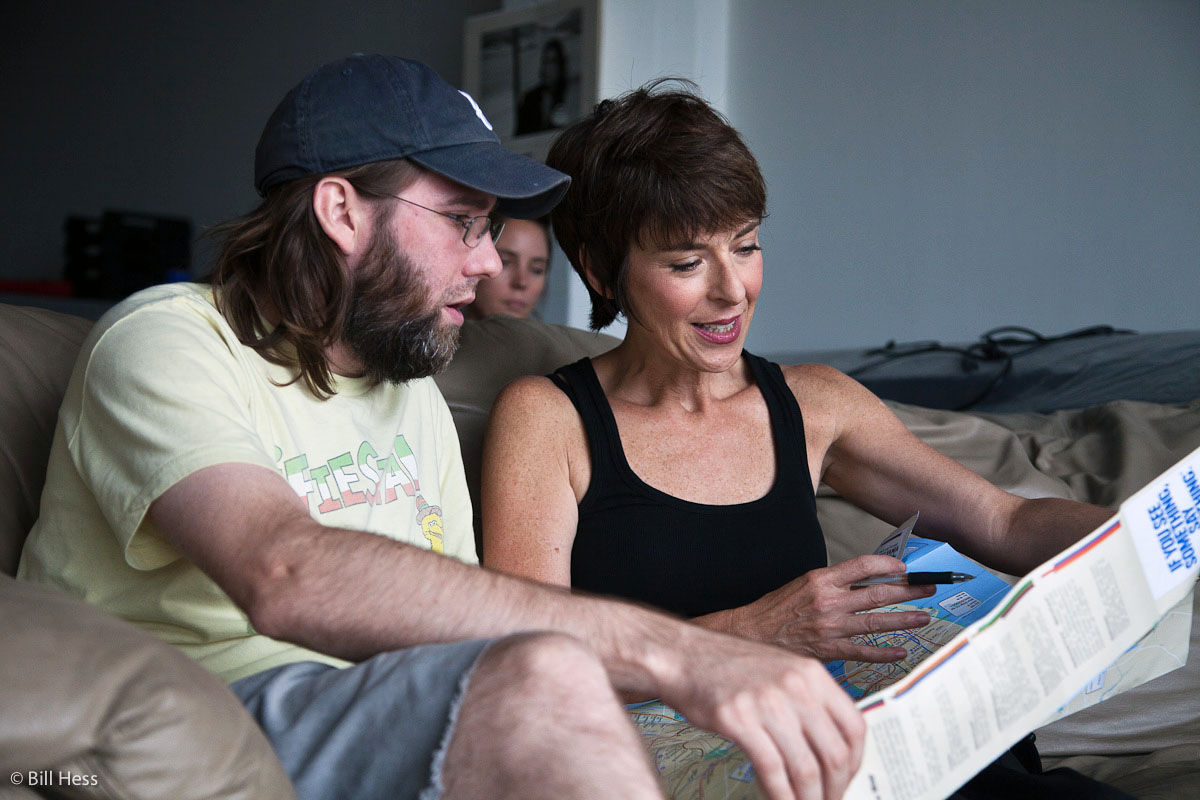 Michael Courvoisier helps Carolyn Beller find the place where she wants to go on the map.
Michael Courvoisier helps Carolyn Beller find the place where she wants to go on the map.
Now - how the hell was I going to accomplish this? I had never once seen a Mormon missionary in New York City. Having grown up in the church and gone through its establishments, I had an innate knowledge that trying to set something up through church and mission authorities would almost certainly be problematic. When I have stumbled upon Mormon missionaries with my camera, I have always found them friendly, open, easy to work with, cooperative about being photographed.
With higher authorities, even those close to me and my family, the opposite has been true. In formal settings, I have had much better success photographing Protestant, Evangelistic, Russian Orthodox, Catholic, Hindu, Native American and the spiritual activities of just about any other religious group than I have with the Mormons from whom I come.
So far, I am pleased with how my own, randomly shot, Looking Back At Me project has developed. I honestly believe that I have gotten more strong, incisive, pictures than I have seen in any other Mormon missionary photo project. There is something about that spontaneous, impossible to plan for moment that no one anticipates or expects that can be most revealing.
Yet, I have often thought that sooner or later, I should shoot a tight essay on one pair, or just a few pairs, of Mormon missionaries - and that I should do so on the South Dakota and Montana reservations where I served. I have given much thought as to how I could go about it. Early on, I rejected the idea of going to mission or other church authorities to help me set it up, because from experience I knew that they would greet such a possibility with great caution, skepticism and an abundance of parameters. If they were to grant their cooperation at all, it would likely come at the cost of parameters that I would not find acceptable.
The Mormon Church goes to endless lengths and spares no expense in its efforts to get its message out, but to the degree that is possible, it also wants to control that message and to head off possible damage before it occurs. I grew up hearing stories about the persecution my ancestors, who were friends and jailmates with Joseph Smith and headed out across the plains with Brigham Young. I heard how badly they suffered as they were driven from the Northeast to the midwest and finally to Utah, and the greater State of Deseret.
As a child growing up in non-Mormon communities, this persecution complex was driven home to me when bullies would gang up on me and beat me up or wash my face with snow because, "we hate you fucking Mormons." I was always taught that, according to prophecy, the time was coming when our Mormon people would be subjected to persecution even greater than that faced by our ancestors.
So I think the persecution complex lingers, and to some degree explains the institutional gunshyness that even I must face as a photographer as I seek to tell my own story.
And yes, my great, great, great, great grandfather had seven wives and 63 children. So that's out of the way. Margie's Apache people also had polygamists among them.

Well, I think that's enough seriousness for this entry. After we had all presented our slide shows, and watched an excellent and moving slideshow on suicide presented by Brooklyn-based photographer Kerry Payne, originally from Queensland, Australia, we walked to a nearby Mexican Restaurant for lunch. This is not Kerry - this is Carolyn Bellor, currently of Chicago, but who speaks with a sourthern accent and who has done a lot of work in the south. Right now, she is shooting in India. She sat across from me at lunch. As photographers tend to be, she was a bit self-conscious about being photographed, but, as most of us also tend to understand, if we are going to shoot others, then we must also yield when others want to shoot us.
She was a good sport about it. She was also quick to laugh, quick to hug and quick to become a friend... and so she remains - a friend, Facebook and otherwise.
That's Kerry Payne to the right, and here is her essay on suicide as it appeared on Burn. She undertook this work in response to the suicide of her father, who took his life at age 60. I, too, am working on a book that deals with suicide. I intend to make it my next book. The people I know who have committed suicide are too numerous to even begin to recall.
We were all pretty hungry. I ordered a chicken burrito which was good, but there were some fish tacos that were better... much better. Carolyn had one and gave me a taste. Boy! I wanted to send my chicken burrito back and replace it with a fish taco, but it was too late.
I think this might be one of those fish tacos. If so, I know why everybody wants it. It looks like Michael got it.
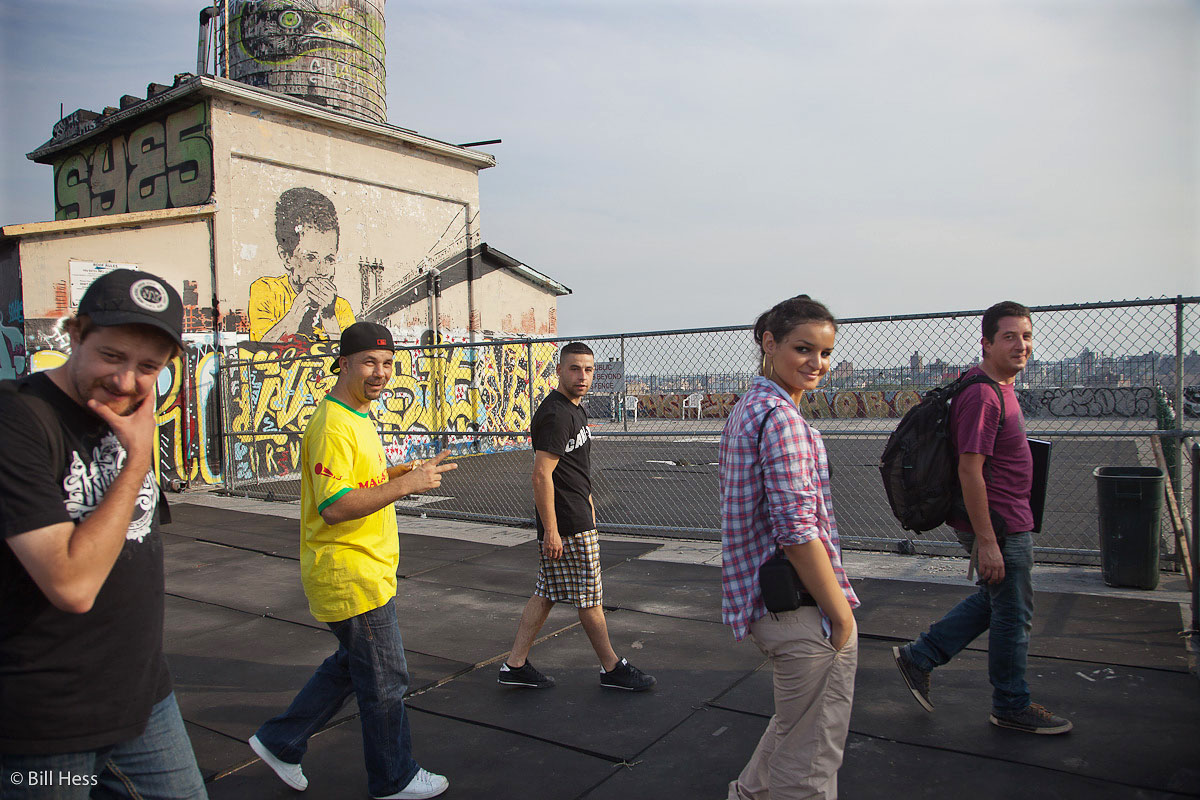
Workshop lunches proved to be fun places to be, so we spent way too much time there. Afterward, we were free to go out and get to work on our essays. First, I had to make a quick trip back to the loft and then up to the roof. I wanted to see if Remi had finished his painting yet. He had. He and his crew were still about, so they gathered atop the painting for me and posed for the picture that opens this post.
Afterward, we said goodbye and then they walked away. Remi gave me his card, but I have lost it. So far, I have not found him on Google. If any reader knows how to contact him, please forward this to him - and his contact info to me.
It was now midafternoon - time to track down some Mormon missionaries in New York City. I pulled out my iPhone and googled, "The Church of Jesus Christ of Latter Saints, New York City." Several numbers appeared. I called them all. Not one call was answered. I heard no voicemail invitation.
The Mormon Church has no paid pastors or preachers. The local bishops and ward leaders gnerally support themselves by taking on paying jobs; some own their own businesses. So I knew the phones probably rang unanswered in empty buildings. I could not think of a good reason that I did not get a single voice-mail request.
One of those numbers was for the New York Mormon Temple, located one block from Central Park across the street from the Lincoln Center. So I walked to the nearest subway station, a good mile away and jumped on the "D" train. Unfortunately, it was the wrong "D" train - the one that turns right when it reaches Central Park, instead of left.
This mistake, coupled with a false correction, cost me at least half an hour. I did not reach the temple until after 5:00. There were no Mormon missionaries anywhere to be seen. Historically, Mormons have built their temples in locations from where they could be seen from far away - but not in New York, where the temple at first appears just be another building, towered over by those that surround it.
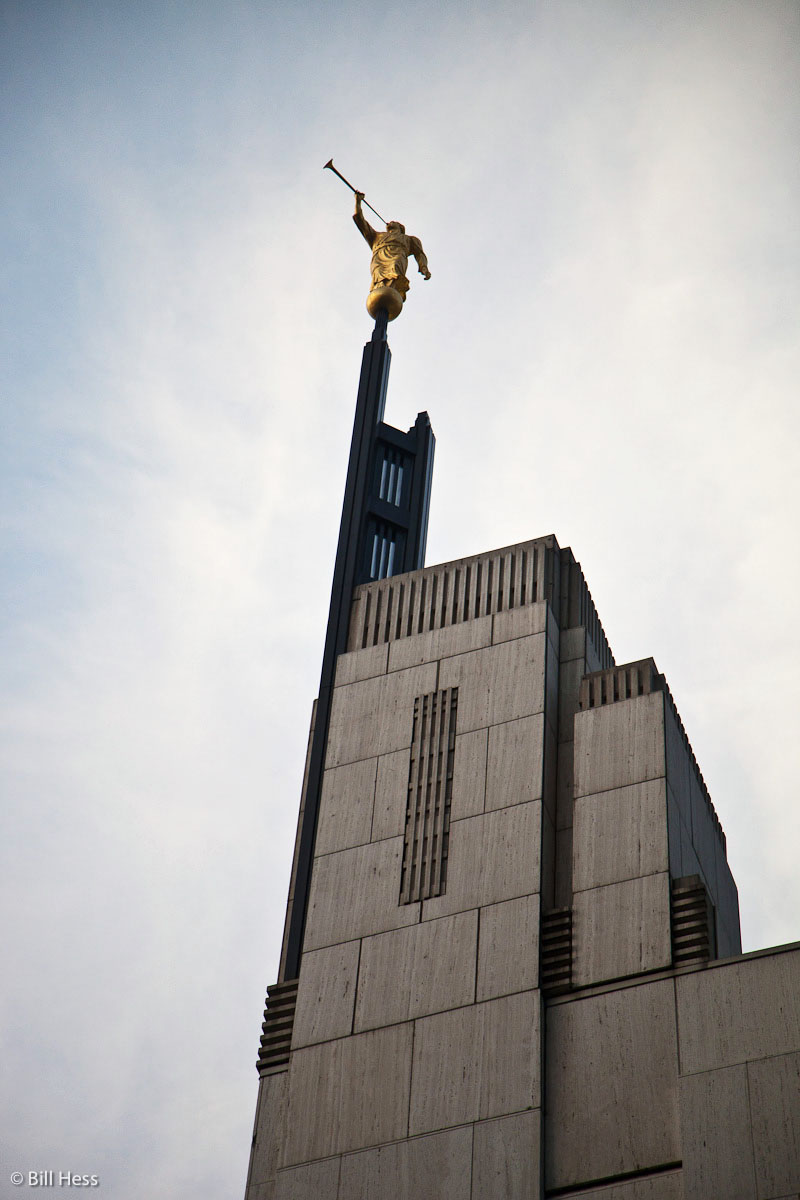
Still, it is the only building with a tall spire atop which a golden angel blows a long trumpet. This is Moroni, and I grew up with him. I had come all this way by foot and subway from Brooklyn, I had put in all this time. I had to photograph something Mormon, so I decided to a series of studies on the Angel Moroni:
Angel Moroni over New York City, Study #2,029: A common view.
In fact, the view was all too common. There was nothing in it to distinguish this statue of the Angel Moroni from others standing atop temple spires around the globe. Somehow, I had to get a picture that said, "Angel Moroni in New York City." I just happened to be eating a pretzel that I had bought from a vendor near the temple's base. Hence:
Angel Moroni over New York City, Study #4: as seen through a pretzel.
Then I realized that while big, soft, pretzels say "New York City" to me, because New York was the first place I ever experienced one, pretzels are common to many places. Plus, the old New York pretzels of distinction seem no longer to exist even in New York City, so the pretzel did not really do the job, either. I had to find a better symbol of New York. Hence:
Angel Moroni over New York City, Study #3,973: the angel and the skyscraper.
Angel Moroni over New York City, Study #4442: the angel and the tall building, with a touch of sky.
Being a wayward Mormon myself, I am in no way trying to preach or convert anyone, but for those who do not know, I should explain the angel. It is Mormon belief that at different times in history, two small groups of Israelite people migrated to the Americas, the second migration taking place about 600 BC, well after the first group had destroyed themselves.
The second group divided into the righteous, white, Nephites and the second into the wicked, dark-skinned, Lamanites. They fought often. During the three days between the crucifixion and resurrection of Christ, there was great destruction in the Americas, which ended when Christ appeared to the Nephite and Lamanite people, who subsequently united in righteousness. For a time afterward, there was no manner of "ites" at all. The suriving inhabitants of the Americas were all just Christ's people. In time, they fell back into their old warring groups. Eventually, the white Nephites became the most wicked of all - so wicked that God allowed the Lamanites to destroy them all, right down to the last man: Moroni.
Before the Lamanites got to Moroni, he took their sacred history and theology, inscribed over the centuries on plates of gold, and buried them in a hill near what became Palmyra in upstate New York.
This is getting too complicated. It does sound like I am preaching. But I am not. It does not matter to me whether you are Mormon, Jew, Hindu, Buddhist, Catholic, Atheist, Evangelistic... whatever. If your religion gets you through this tough life, and you don't use it as an excuse to hammer down and trample on anyone else, particuarly me, then I am fine with it and I will accept you whatever you believe.
I'm just telling you what was taught to me first by my loving mother as she sat at my early bedside, so that you will know why the Mormons have placed this angel atop a tall spire just off Central Park in New York City.
Anyway, it is Mormon belief that Moroni everntually resurrected and in the early 19th Century entrusted the Golden Plates to Joseph Smith, who translated the smaller part of them into the Book of Mormon, named for the prophet of that name and founded The Church of Jesus Christ of Latter Day Saints - The Mormons. Then Smith returned the plates to Moroni, who would again put them away from safekeeping until the world was ready to have the larger portion unsealed and translated as well.
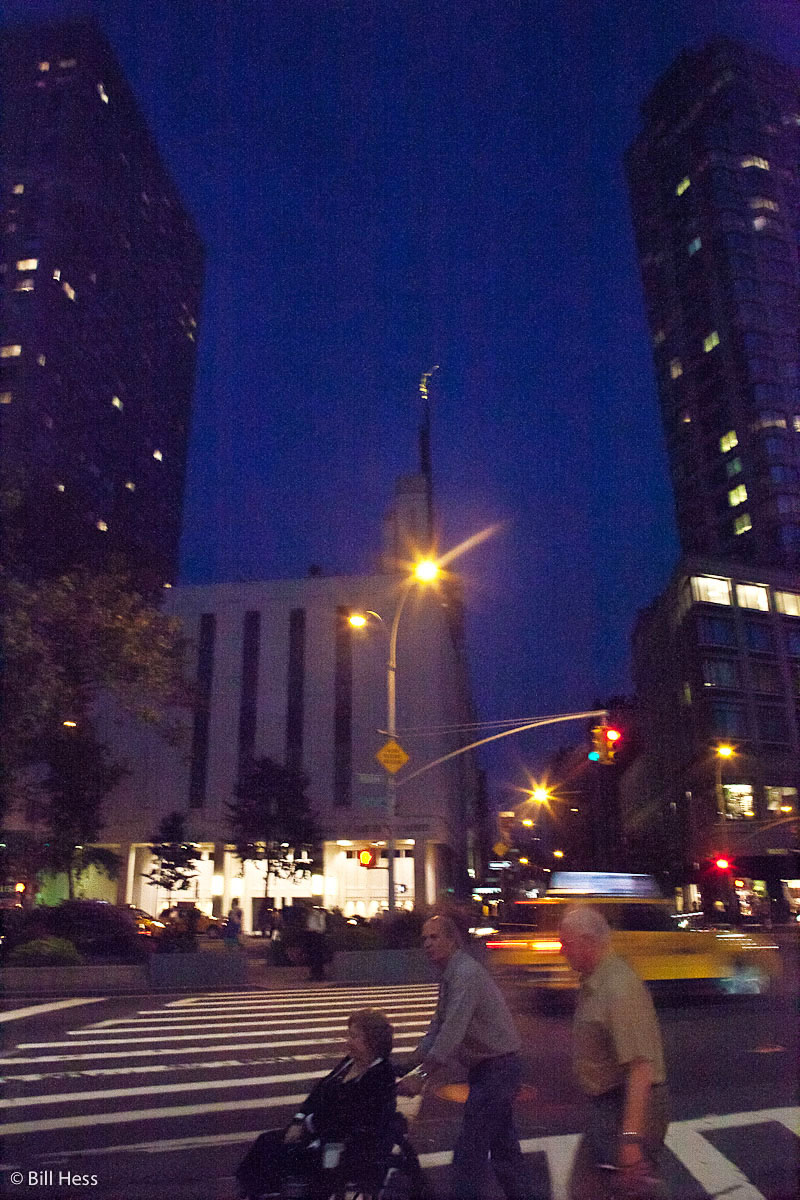
Angel Moroni over New York City, Study # 9: a wheelchair passes beneath.
Conversely, it is not now my intent to either deride the Mormon faith or try to dissuade anyone from it. When I meet people of faith, any faith, I do not like to attack or try to weaken their faith. I recognize the strength they get from it. This includes Mormons, Catholics, Sikhs - everybody. I just want to tell my own story. My own faith took a beating and I never found answers to overcome the many questions that arose. I will not go into those questions now, but they were many.
One of the biggest of all involves a wheelchair. Don't try to guess. If I live long enough to assemble the photos that on this subject that I have already completed and cannot add one more to, then my explanation will be available to you. You can reject that explanation; proclaim my faith to have been weak and me, unvaliant. That's okay. It's just a story I must tell.
Angel Moroni over New York City, Study #42: angel at the window.
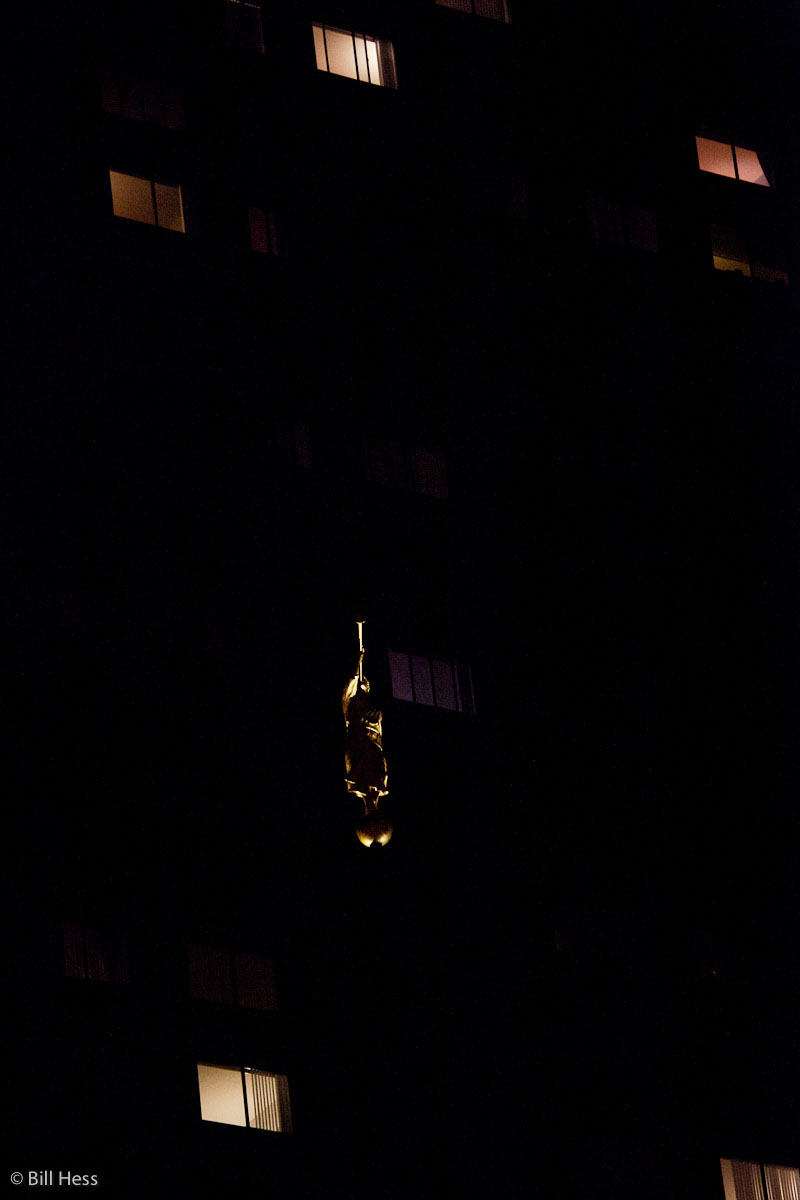
Angel Moroni over New York City, Study #1: time to go home...
...home being an apartment in Brooklyn that I was sharing with four other Loft Workshop students. There is a subway station at Lincoln Center, just beyond the temple doors, but I walked to the one at Columbus Circle, about six blocks away.
Just before I reached it I came upon this scene and stopped to take a picture. I overheard enough of the conversation to know that the young man was a stranger to the young women. They had stopped him, asked him if he would mind taking a picture for them and had entrusted him with one of their cameras.
I imagined what it might have been like if I could somehow have been a young man, stopped by the women. After I had taken the picture, I would have handed the camera back to them.
"Thank you," they would have said.
"Oh, no problem," I would have responded. "My pleasure."
"Would you like to walk with us for awhile," the one on the right would have asked.
"I was headed to the subway," I would have answered. "But it's a nice night, and it's too hot down in the subway. Sure. Why not?"
And off we would have walked.
I boarded the train, got off at the wrong stop, then had to wait much longer than usual, but finally a train pulled up.
My mother loved to sing, and what she sang mostly were Mormon hymns, and Mormon primary songs for children. Except to attend funerals, I have not been inside a Mormon Church for at least 25 years. Yet, most mornings when I wake, it is to the sound of Mormon hymns playing in my head.
After my mother died, not only in the morning but many times throughout the day, for many days, weeks, months... even now, sometimes, nearly six years later... I hear one of those hymns, sung solo, without accompaniment, in her voice. I see her, standing, short but above me, singing with that enraptured look she used to get, her hands clasped in front of her chest...
"There is beauty all around..."
Yep, Mom, you sang correctly - beauty, all around - even in the dreary depths of the New York subway system.

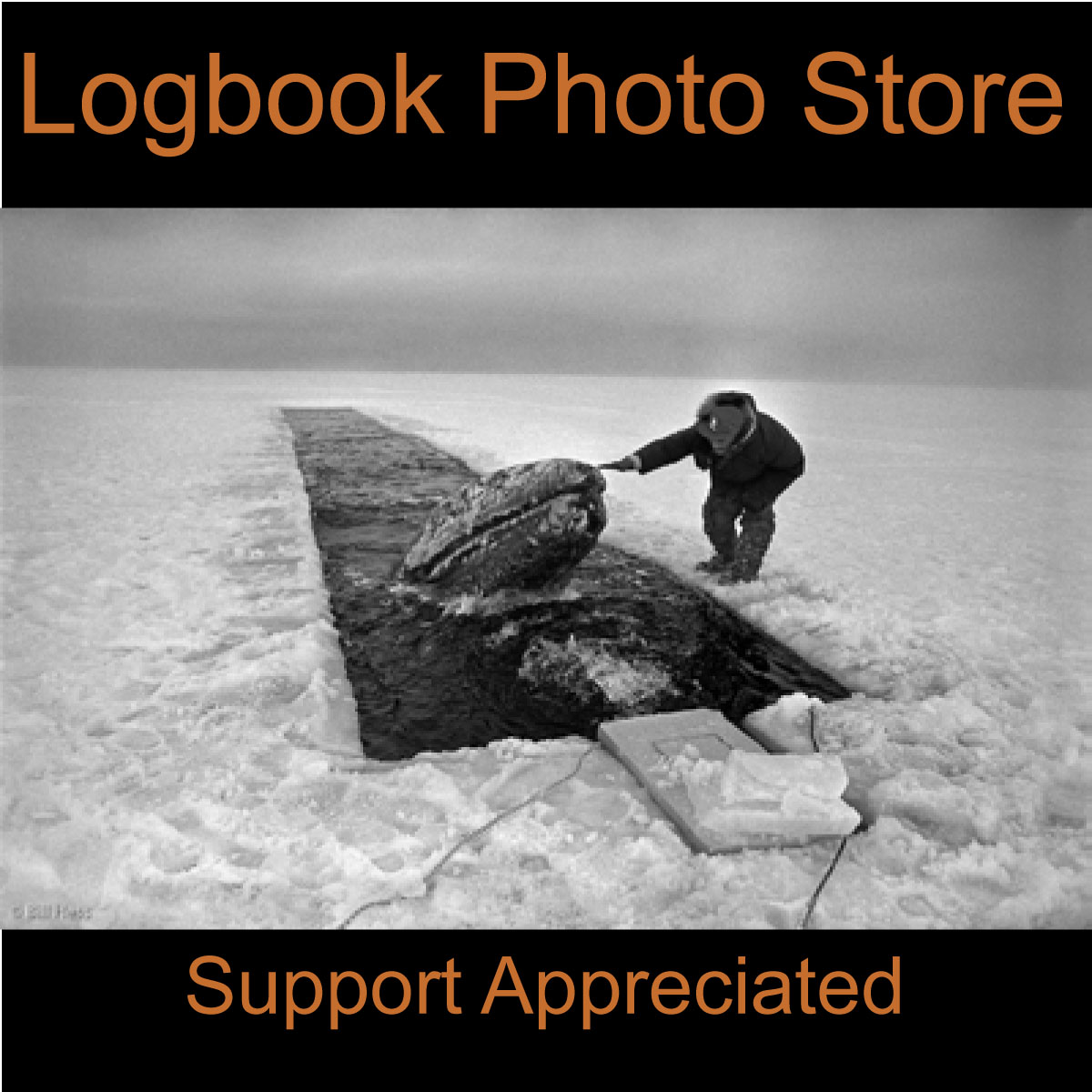
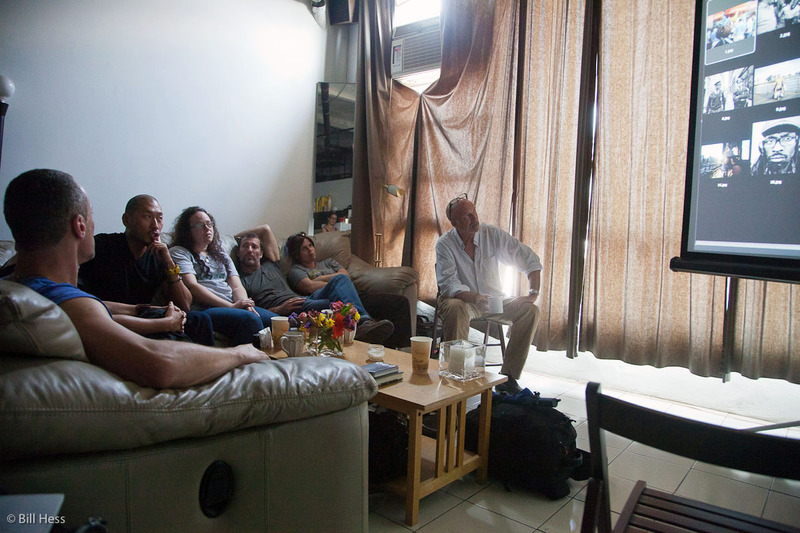
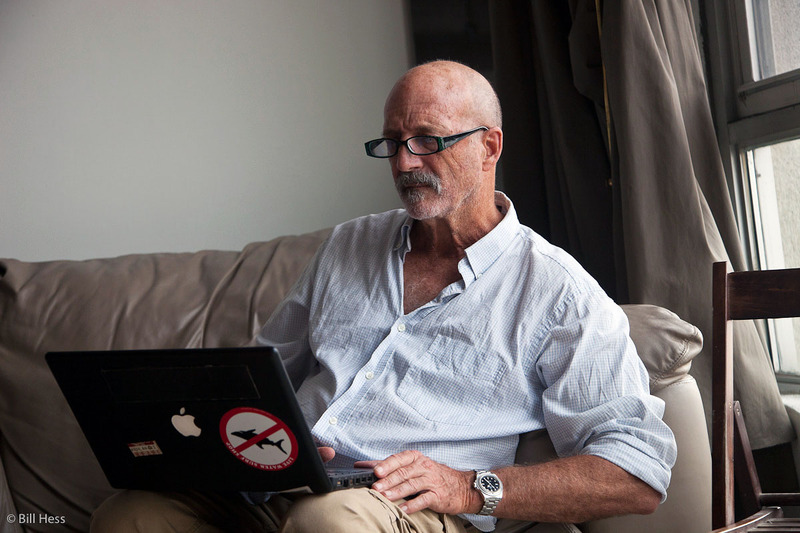
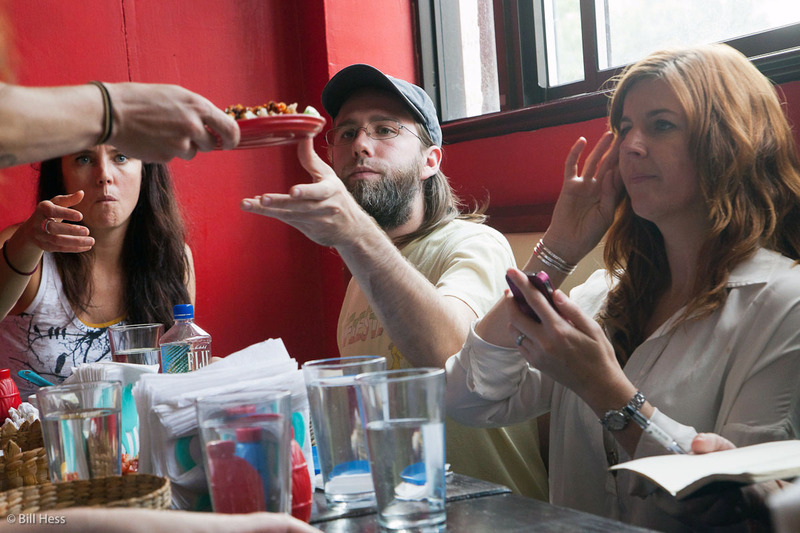
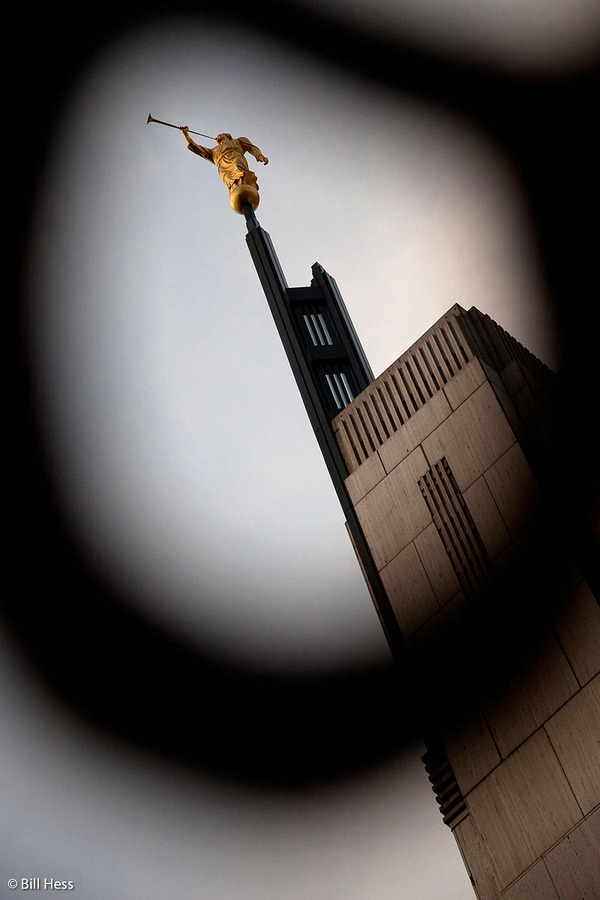
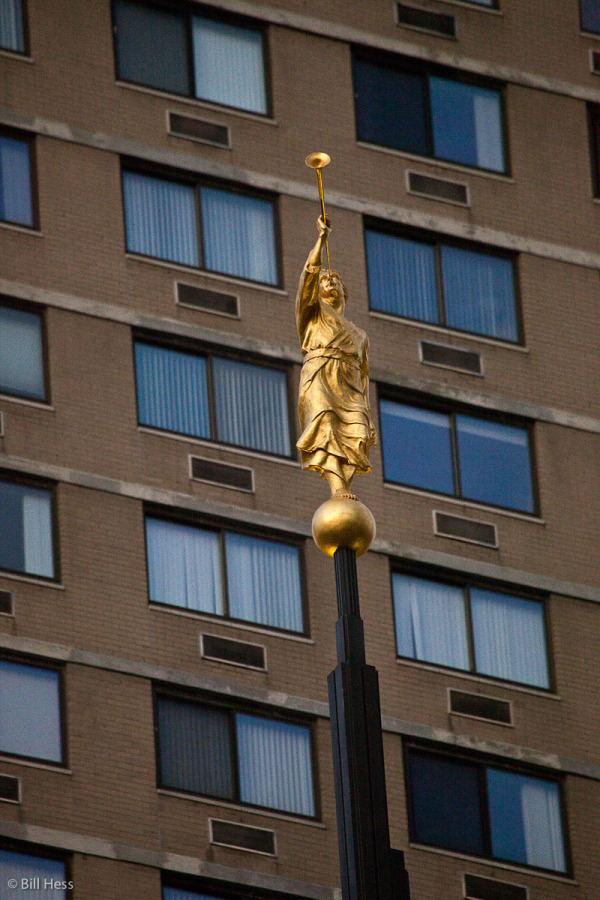
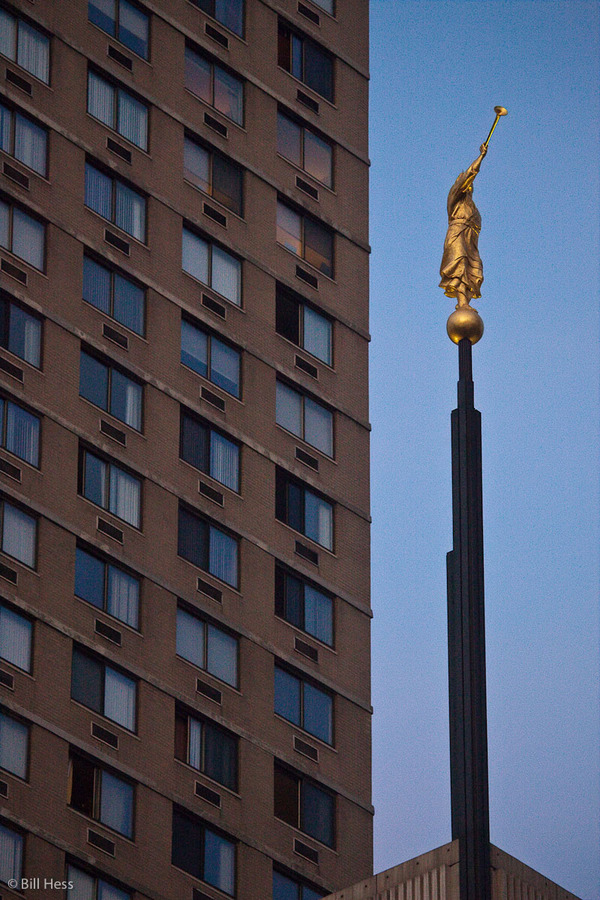
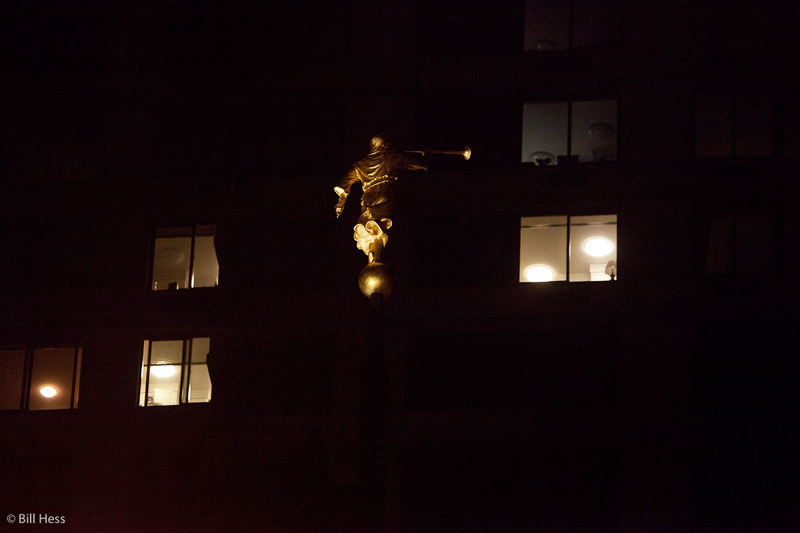
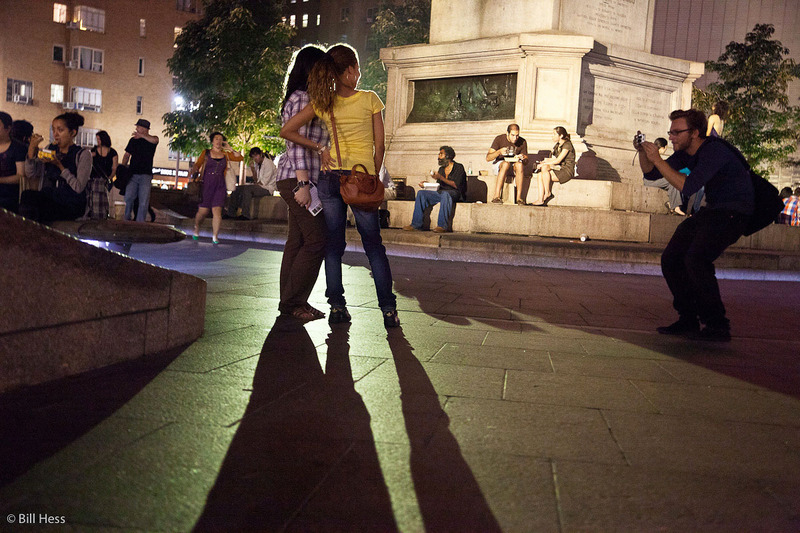
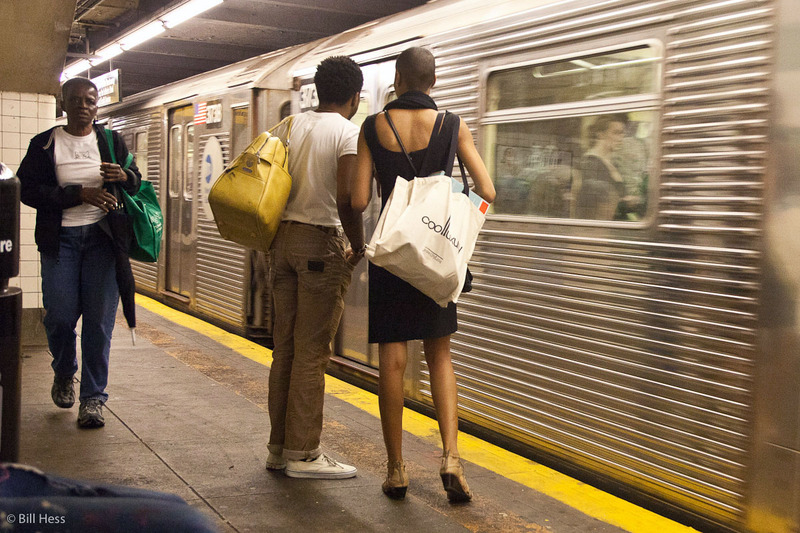
Reader Comments (13)
Bill...
I'm enjoying all these posts, they're wonderful. I'm also finding all the Mormon insights highly interesting and this is coming from a guy who doesn't usually have much time or interest in religion. You're a great storyteller, I bet you're perfect company for a lovely evening campfire. :)
Hey Bill
I'm loving this. I hope we get a look at the photos you brought for the critique.
Do you have a count on how many people are following the blog?
Enjoying this very much, looking forward to each installment. You are so talented, you really must finish and publish one of your many photo projects!
I knew that this was coming.. this is not about photography at all, this is about facing your demons.. not this post I mean, but the purpose of the workshop..
What a lovely memory of your Mother Bill. I'm sure she still watches over you.
The picture of the Angel Moroni at night blowing his trumpet toward the lighted window - this to me is the most powerful of the images. (Disclosure: I'm a lapsed Catholic and, like you, don't have any brief against any other religion or person who follows that religion or those who chose no beliefs). But the picture of the Angel at Night.... there's a sort of expression of faith in it, as if the Angel is sounding a call to those who are awake to hear it. Beautiful picture!
This new blog of yours is good - I'm looking forward to more stories about the Loft!
Paul - I appreciate the thought, especially since I have this feeling that I am going overboard here.
Gordon - In time, hopefully. I am not ready to put those pictures up here yet. I told David that I would on them a little more and then send a set to him - not so much as a submission to Burn, but as a starting point to begin working on a book. Yet, if David wanted to put them on Burn, then that would be a good place to start.
As to the count - yes - I will keep that to myself for now, but I will say this: my count is running less than 25 percent of what it was on my original Wasilla blog. It has dropped terribly. In fact, my old blog continues to do far better than the new, even without anymore daily posts. It is a bit discouraging, but part of the initial cost of trying to move on.
Yes, Eva - yet, I think in general serious photographers are always trying to take on their demons, so that makes it about photography, afterall.
ManxMamma - That is both a comforting and disturbing thought, because if she is watching over me, then she knows for certain that I am not the fine, upstanding Mormon priesthood holder that she raised me to me.
Sutton - I appreciate that perspective. I think I may agree.
Bill.. yes.. but laying them out before others, as you have to do in a workshop, is different than just being alone with them.. gotta say that what you wrote and what Zun Lee's project is about is something very sensitive to me, so perhaps I project too much and much too personal feelings into this..
Eva - yes, you are right about the difference between being alone and being in a workshop. As it happened, though, this was a very supportive workshop. I could not detect anybody trying to do any one-upsmanship or to put anyone else down... so, when you must face demons in a group setting, I think that helps a lot.
I feel a little badly to have dropped my pain on your wounds and to have been an instrument in bringing back your own pain. I guess that is part of it, though - no way around it except to hold everything in. Sometime, I hope you will share more of this with me, or with me through everybody.
Bill-
I'm sorry folks haven't yet followed over here to your new blog. They are missing out.
For myself and retreating to the slang of my long ago youth, the visual changes here as well as this series on the workshop have been blowing me away.
Whatever your hopes and intentions for choosing the tighter shot of the right-before-the-light-was-gone photo of Remi were, what you ended up with was an eyeopener to me.
As a rural, small town soul who is overwhelmed and close to hyperventilating in metropolitan surroundings, that discrete moment you caught acted as a giant wa-thump! both feet back on the ground for me.
I starve, almost immediately, in a city, for the connections to light and dark and air and water and earth which inform my day so richly. It is over simplistic but true to say I had never noticed or seen the sun also sets on cities.
Much to think about there as regards my own personal journey,
Thank you for sharing yours.
Bill.. no feeling bad, please.. I could have stay put, my own responsibility.. all fine :)
Alaska Pi - I think it is just a matter of time. I also think New York City is the one city that everyone in the US ought to visit, if they get a chance to visit just one city and no other.
Eca - truth is, you lift my spirits on a regular basis - not just here, but on Burn, Rio, etc,
Bill, I had to read this several times, because your recollection of that day - the minutiae as well as the big thoughts - are interesting for two reasons. First, it's fills in the gaps of what happened and how you felt while you were roaming the streets of NYC in search of missionaries. Second, I was still in a bit of a daze as to why I was there and what I was going to do that week - until you showed your essay.
At that moment, everything snapped into focus. I didn't know how I would go about it, but I just knew I had to do it, and that my calculations re. perhaps choosing an "easier", more accessible theme were ill-advised. Little did I know what would await me that week, but in that moment, you opened my heart to the possibilities.
You're Mom was right. "There is beauty all around, when there's love at home"...